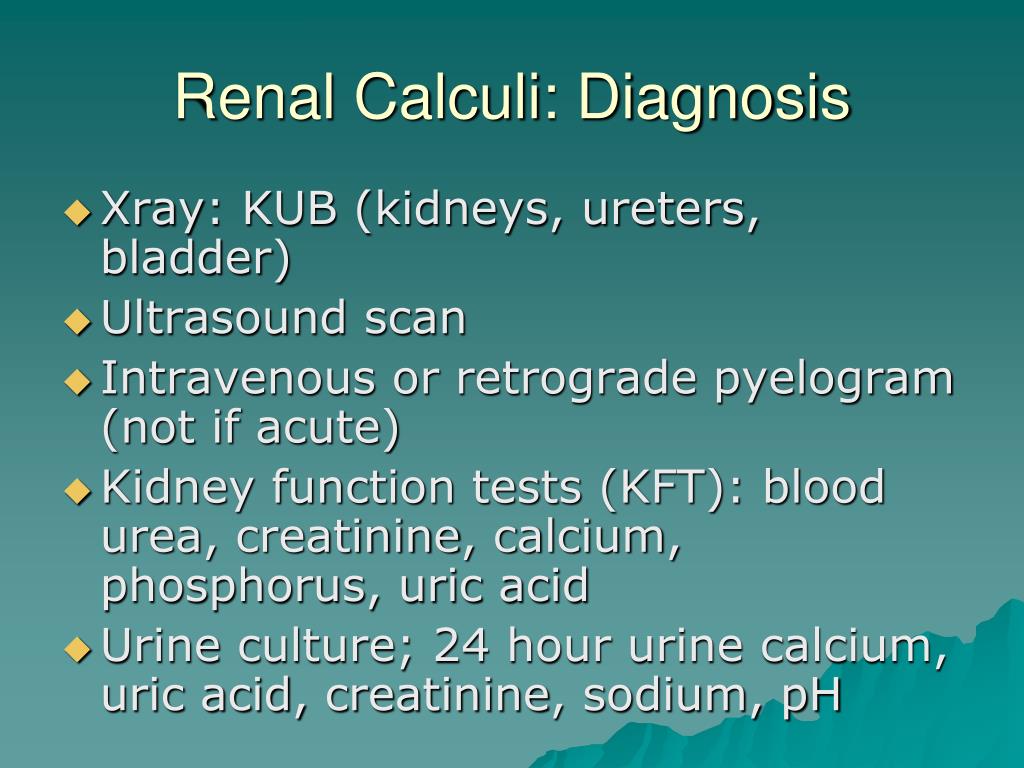
3-D pictures help to determine the location of the kidney stone. CT scan: the child lies flat on a bed that slides into a doughnut-shaped device.The images created may show the location of the stone(s). This is a painless test using sound waves to take pictures of the kidneys, ureters and bladder. The technician slides a hand-held device (transducer) across the child’s skin.

Renal ultrasound: the most common radiologic test used to diagnose a urinary tract stone.The following may be used to diagnose and locate stones: Kidney stones are often diagnosed in the Emergency Department, when children come in with severe belly or side pain. Decreased water intake or long periods of dehydration.Some gastrointestinal diseases or surgeries, such as gastric bypass surgery or inflammatory bowel disease, can cause the intestines to absorb more oxalate from foods and form calcium oxalate stones.įactors that place a child at increased risk for developing kidney stones are:.Pay close attention to fluid intake if your child has these conditions. In conditions that cause chronic diarrhea, such as Crohn’s disease or ulcerative colitis, kidney stones are more likely to form due to the excessive fluid loss.This condition can be corrected with medications and changes in your diet.Citrate helps remove extra calcium in the urine and can help prevent calcium crystals from forming kidney stones.When citrate is low in the urine, calcium and uric acid kidney stones can form.Low citrate can be related to diet or medicine. Hypocitraturia means there are low levels of citrate in the urine.Hypercalciuria is the most common genetic cause of kidney stones.Some medications can cause hypercalciuria.High salt in the diet can cause hypercalciuria.As discussed above, this can be due to various factors such as genetic predisposition, high sodium intake and / or medications. Hypercalciuria means the urine has a very high level of calcium. Hyperoxaluria is where the liver makes too much oxalate leading to kidney stones made from oxalate. Hyperparathyroidism can cause too much calcium to be pulled from bones leading to high calcium in blood and urine.Ĭystinuria is an inherited genetic disorder where there is too much of the amino acid cysteine in the urine that can lead to cysteine stones. Medical conditions that can cause urinary stones: You will be encouraged to eat a log of vegetables and fruits, especially citric fruits, to make your urine richer in citrate. Your doctor may prescribe potassium citrate. Some types of calcium stones are more likely to form in urine that is low in citrate. Urinary citrate, a natural substance in the urine, protects against kidney stone formation. Some medications may cause low urinary citrate. Your doctor or dietitian can give you specific guidelines to help reduce your sodium intake. The best way to decrease calcium stones is to reduce sodium in your diet. This can occur when eating a lot of processed and fast food or using too much table salt. Some people pass larger levels of calcium into their urine when they eat a high sodium diet. Calcium stones are usually cause by the way kidneys process salt in your diet. The most common kidney stones are made from calcium. Increasing fluid intake will dilute the urine and decrease the chance of stone formation. This causes the urine to become concentrated and dark in color. Low urine volume happens when a child does not drink enough fluids. What Causes Kidney Stones to Form? Low urine volume: Struvite stones form when someone has frequent urinary tract infections.A diet rich in animal proteins may contribute to this kind of stone. Uric acid stones form when the urine has too much uric acid in it.Cystine stones result from a genetic disorder where cystine leaks through the kidneys into the urine.Calcium stones are the most common type of kidney stones.The four main types of kidney stones are:

Kidney stones may form quickly or slowly over time. This is more likely to happen if you do not drink enough fluids. A kidney stone is formed when normally-occurring mineral residue sticks together making a larger solid piece of material.

In kidney stone disease, or nephrolithiasis, stones (calculi) are present in the urinary tract.


 0 kommentar(er)
0 kommentar(er)
